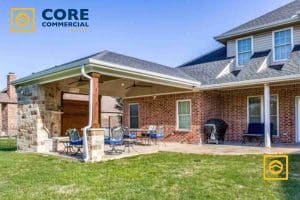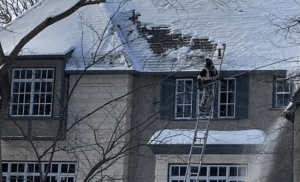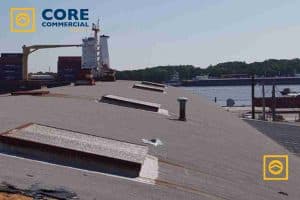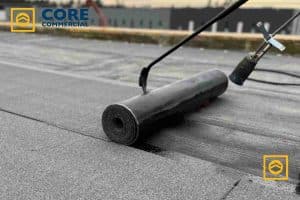Texas weather is tough on commercial roofs. Blazing heat, intense UV rays, sudden storms, hail, and even freezing temperatures can all cause leaks that disrupt businesses and cost thousands in repairs. Thankfully, there are proven, effective leak-stop coating methods that help prevent leaks before they start—or seal them up fast when they do. In this guide, you’ll discover 10 coating solutions used across Texas to protect flat and low-slope commercial roofs. Whether you’re dealing with small roof cracks, ponding water, or widespread membrane damage, these methods can help you extend your roof’s life, reduce costs, and keep your building dry and damage-free.
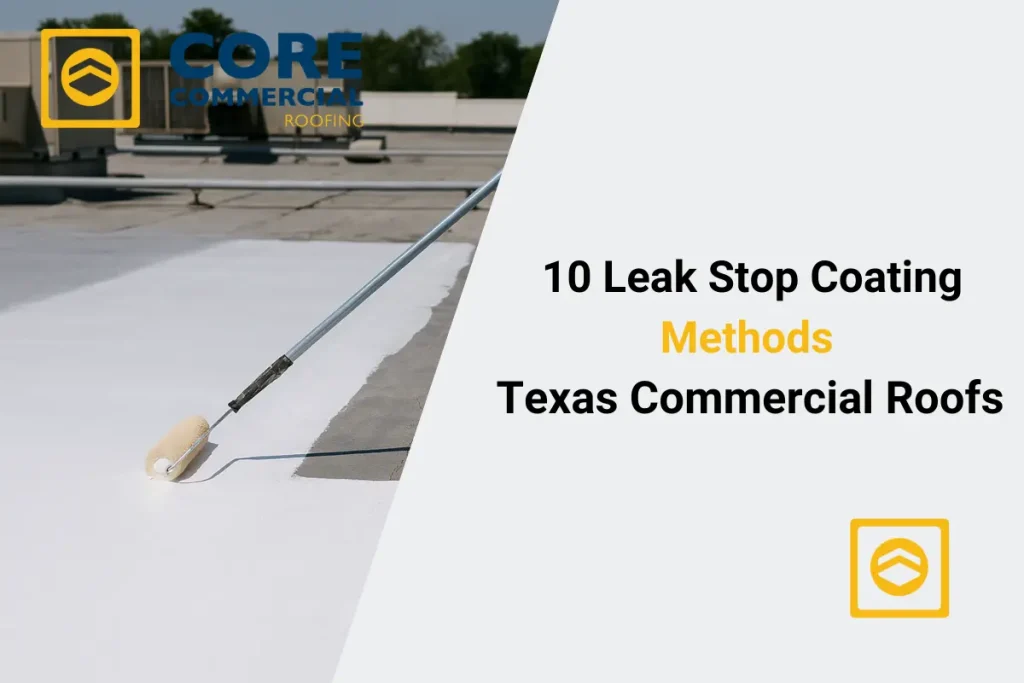
Table of Contents
Why Roof Leaks Are a Big Deal for Texas Businesses
When your roof leaks, it’s not just a puddle on the floor. It can shut down operations, damage inventory, raise insurance premiums, and cost you good tenants or customers. Texas businesses, especially in hot cities like Dallas, Houston, San Antonio, and Austin, face extreme roof stress from the sun and storms.
Water seeps in through cracks, seams, or aging materials, leading to:
- Mold growth poses that risk to health violations
- Electrical hazards that threaten safety
- Rising repair bills from hidden structural damage
- Damaged insulation that increases cooling costs
The sooner you stop leaks, the better. And the best time to act is before they start.
What Is a Roof Coating System?
A roof coating system is a liquid-applied layer that forms a protective, waterproof membrane over your roof. It’s not just paint—it’s a sealant that bonds to the surface, covers seams and cracks, and reflects heat.
Most coatings are applied over flat or low-slope commercial roofs, including those made of:
- Modified bitumen
- TPO (Thermoplastic Polyolefin)
- EPDM (rubber)
- Metal
- Built-up roofing (BUR)
Coatings offer leak prevention, UV protection, heat reduction, and extended roof life—all without replacing the entire roof.
1. Silicone Roof Coatings
Best for: Texas heat, UV exposure, and ponding water
Silicone is one of the most popular leak-stop coatings in Texas. It’s a thick, durable material that stands up to intense sun and permanent ponding water.
Benefits:
- Resists cracking and UV degradation
- Waterproof even under standing water
- Highly reflective—lowers building temperature
- Excellent for flat commercial roofs with poor drainage
When to use it: When your roof shows signs of aging but isn’t ready for full replacement, or when ponding water is causing slow leaks.
2. Acrylic Roof Coatings
Best for: Cost-effective sun protection in dry Texas climates
Acrylic coatings are water-based and ideal for reflecting UV rays. They’re more affordable than silicone, but not great with ponding water.
Benefits:
- Inexpensive and easy to apply
- Reflects 80–90% of UV rays
- Great for sloped metal or single-ply roofs
- Dries fast in Texas’s hot, dry climate
When to use it: On sloped commercial roofs in dry regions like West Texas or Central Texas, where ponding isn’t an issue.
3. Polyurethane Roof Coatings
Best for: High-traffic commercial roofs and hail resistance
Polyurethane is a tough, impact-resistant coating. It’s perfect for roofs that experience foot traffic, like retail centers, hotels, or maintenance zones.
Benefits:
- Strong resistance to impact and hail
- Handles expansion and contraction well
- Ideal for foam and concrete roofs
When to use it: In hail-prone areas like the DFW Metroplex or Panhandle, or where roof repairs need added durability.
You should learn: commercial roofing systems
4. Elastomeric Coatings
Best for: Seamless, flexible waterproofing on aging roofs
Elastomeric coatings stretch and contract with your roof, making them ideal for sealing around flashing, vents, and seams that leak over time.
Benefits:
- Flexible, even in cold or hot temperatures
- Good for patching leaks around joints
- Creates a seamless waterproof barrier
When to use it: On aging commercial roofs with minor cracking, leaks near vents or HVAC units, or visible seams that separate in the heat.
5. Bitumen-Based Sealant Coatings
Best for: Quick patch jobs on modified bitumen and BUR roofs
This asphalt-like coating is thick, black, and super sticky. It’s perfect for emergency patches or reinforcing known trouble spots.
Benefits:
- Bonds well with bitumen roofs
- Quick and affordable for patching
- Good temporary fix until full recoat
When to use it: For rapid, low-cost leak fixes on older built-up roofs or to seal cracks after storms.
6. Foam Roof Coating Systems (Spray Polyurethane Foam + Coating)
Best for: Energy efficiency and waterproofing in one layer
SPF systems combine insulation and leak protection. A foam layer is sprayed directly onto the roof and topped with silicone or acrylic coating.
Benefits:
- Insulates and waterproofs at once
- Creates a fully seamless surface
- Fills dips or uneven roof areas
- Reduces HVAC load and energy bills
When to use it: For buildings with high energy costs or older roofs needing improved drainage and insulation.
7. Aluminum Reflective Coatings
Best for: Metal roof leak prevention and heat reflection
These coatings use aluminum particles to reflect sunlight and seal small gaps in metal seams or fasteners.
Benefits:
- Helps stop metal roof leaks at seams
- Reduces rooftop heat absorption
- Affordable and fast to apply
When to use it: On older metal roofs in hot climates like Houston or Austin to reduce cooling costs and prevent rust.
8. Rubberized Liquid Membrane Coatings
Best for: High-flexibility sealing around joints and roof details
These coatings are applied in liquid form and cure into a tough rubber sheet. They’re especially good at sealing edges, wall transitions, and penetrations.
Benefits:
- Extremely flexible and durable
- Great for irregular roof shapes or joints
- Works on almost any roof material
When to use it: To target persistent leaks near walls, flashing, or where other coatings can’t seal completely.
9. Cementitious Roof Coatings
Best for: Protecting concrete roofs or parapet walls from leaks
These thick, cement-based coatings resist UV, water, and thermal changes. They’re often used on rooftop equipment pads and parapets too.
Benefits:
- Strong resistance to water and fire
- Bonds well to concrete
- Ideal for industrial or government roofs
When to use it: On concrete or masonry roofs, or where long-term durability is more important than flexibility.
10. Hybrid Roof Coating Systems
Best for: Combining strength, flexibility, and weatherproofing
Some contractors use custom systems that layer coatings—like a polyurethane base and silicone topcoat—to maximize protection and savings.
Benefits:
- Tailored to specific roof problems
- Maximizes performance and cost-effectiveness
- Allows upgrades without full tear-off
When to use it: When your roof has multiple problem areas, or when you need a custom solution to get the longest life from your roof.
How to Choose the Right Leak-Stop Coating in Texas
Choosing the right coating depends on your roof’s condition, material, slope, and location. Here’s what to consider:
| Factor | Coating Type | Why It Matters |
|---|---|---|
| Roof material | TPO, EPDM, BUR, metal, etc. | Not all coatings stick to all surfaces |
| Slope and drainage | Silicone, foam | Some coatings resist ponding water better |
| Foot traffic | Polyurethane | Needed for durability |
| Sun exposure | Acrylic, aluminum | Reflective coatings reduce heat damage |
| Storm risk | Hybrid, polyurethane | Hail and wind resistance |
| Budget | Acrylic, bitumen | Lower-cost options for smaller projects |
When Should You Recoat or Seal Your Roof?
Recoat every 5–10 years, or sooner if you see:
- Water stains inside your building
- Bubbling or cracking roof surface
- Standing water after 48 hours
- High energy bills from roof heat gain
Getting ahead of leaks saves thousands. Most coating projects cost far less than roof replacement and take only 1–2 days.
Real Benefits for Texas Businesses
Here’s what commercial property owners and facility managers in Texas get when using these leak-stop coatings:
- Fewer leaks and repairs year after year
- Lower energy bills from heat-reflective coatings
- Avoid costly replacements with roof life extensions of 10–20 years
- Improved property value and building protection
- Peace of mind during storm and hail seasons
Final Thoughts: Seal Leaks, Save Money, Stay Cool
If your Texas commercial roof is leaking—or if you want to avoid major issues before they start—these 10 roof coating methods can save you time, money, and stress.
Whether you’re in Dallas, Austin, San Antonio, Houston, El Paso, or anywhere between, there’s a solution that fits your roof type, weather challenges, and budget. From silicone that withstands ponding water to foam systems that cut energy costs, these coatings protect your investment while keeping operations dry and smooth.
Don’t wait until the damage is done. A simple coating today can prevent a full roof replacement tomorrow.
FAQs
What’s the best roof coating for Texas commercial roofs?
In Texas, silicone coatings are ideal for flat roofs with ponding water due to their waterproof nature. Acrylic coatings are cost-effective and reflect sunlight, making them suitable for sloped roofs in sunny areas.
How can I stop leaks on my flat commercial roof in Texas?
To stop leaks on flat commercial roofs in Texas, apply a silicone roof coating to seal cracks and prevent water infiltration. Regular inspections and maintenance also help in early leak detection.
Does roof coatings help reduce energy bills in Texas?
Yes, reflective roof coatings like white acrylic can lower roof temperatures by reflecting sunlight, reducing cooling costs during hot Texas summers.
How often should I recoat my commercial roof in Texas?
Typically, every 10-15 years, depending on the coating type and roof condition. Regular inspections can help determine the best time for reapplication.
Are roof coatings suitable for metal commercial roofs in Texas?
Yes, aluminum reflective coatings are great for metal roofs in Texas. They prevent rust, seal small gaps, and reflect heat, enhancing energy efficiency.
What’s the cost-effective way to fix commercial roof leaks in Texas?
Applying a roof coating is often more cost-effective than a full roof replacement. It extends the roof’s life and prevents leaks without the higher cost and disruption of replacement.
How effective are roof coatings in extending the lifespan of commercial roofs in Texas?
Absolutely. Roof coatings add a protective layer that shields against sun, rain, and temperature changes, potentially adding 10-20 years to your roof’s lifespan.
Which roof coating is best for high-traffic commercial roofs in Texas?
Polyurethane coatings are durable and resistant to impact, making them suitable for high-traffic areas on commercial roofs in Texas.
Do roof coatings prevent mold and mildew on commercial roofs in Texas?
Yes, by sealing leaks and preventing water accumulation, roof coatings help inhibit mold and mildew growth on commercial roofs in Texas.
Are roof coatings environmentally friendly for Texas commercial buildings?
Many roof coatings are eco-friendly, reducing energy consumption by reflecting heat and extending the roof’s life, thereby decreasing waste from roof replacements.



